Subtotal: ₦1,767,382
Your mattress and pillows work hard every night, giving you support through countless hours of sleep. To keep them comfortable and lasting longer, they need the right care. I’ll walk you through simple steps to keep your bed fresh, clean, and comfortable for years.
Why Mattress Care Tips Matter
Before we get started, it’s worth knowing why mattress care matters. You spend about a third of your life in bed, so your mattress gets plenty of use. If you skip regular cleaning, dust mites and moisture can build up, which isn’t great for your sleep or health. Keeping your mattress clean helps cut down on allergies and improves your sleep quality. Just a bit of regular care can keep your mattress comfortable and lasting longer.
How to Clean a Mattress: The Complete Process
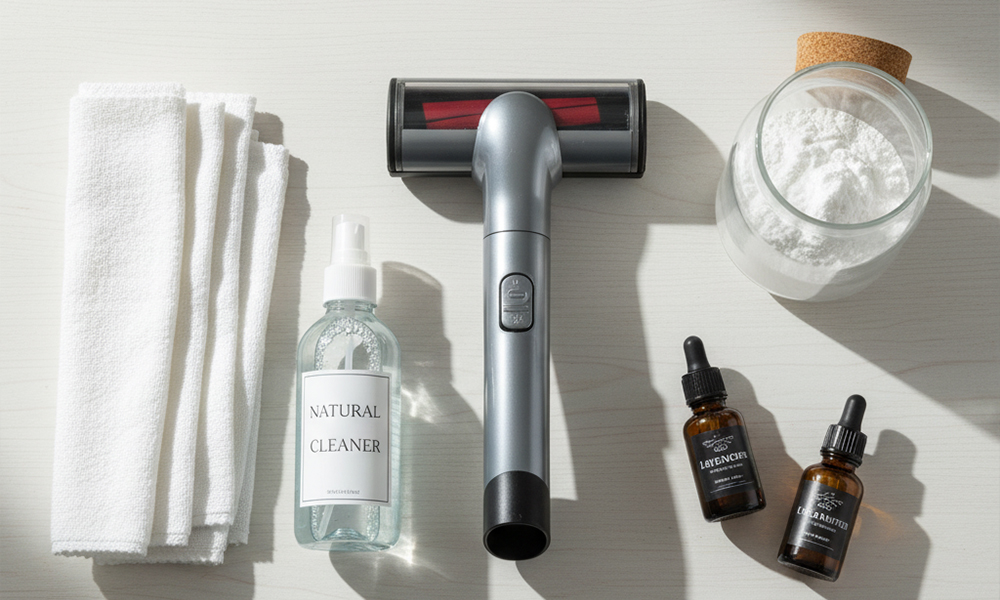
Monthly Maintenance: The Foundation of Mattress Care
What you’ll need:
- Vacuum cleaner with upholstery attachment
- Baking soda
- Essential oils (optional)
- Clean cloths
- Mild detergent
Step 1: Strip and Vacuum. Remove all bedding and wash it according to care instructions. Using your vacuum’s upholstery attachment, thoroughly vacuum the entire mattress surface, paying special attention to seams and crevices where dust and debris accumulate.
Step 2: Deodorize with Baking Soda. Sprinkle a light layer of baking soda over the mattress. For a fresh scent, add a few drops of essential oil to the baking soda. Let it sit for at least 15 minutes, or longer if you can. Baking soda naturally absorbs odors and moisture.
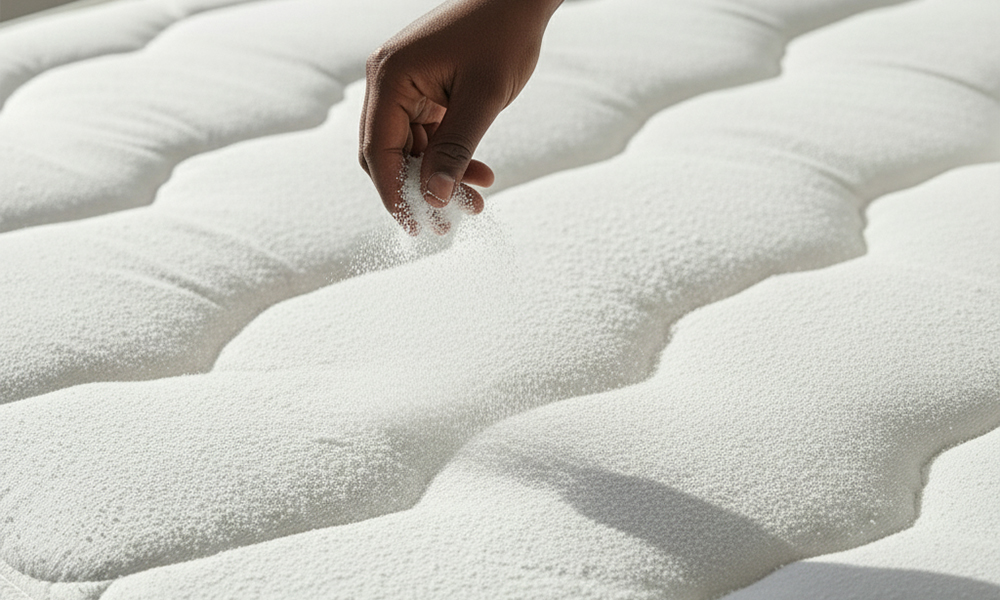
Step 3: Vacuum Again. Vacuum up all the baking soda thoroughly. This simple process removes odours and helps keep your mattress fresh between deep cleans.
Quarterly Deep Clean: Tackling Stains and Spots
For Fresh Stains:
- Blot (never rub) immediately with a clean, dry cloth to absorb as much liquid as possible
- Mix cold water with a small amount of mild detergent.
- Dip a clean cloth in the solution and gently blot the stain.
- Use a separate cloth dampened with plain water to rinse
- Blot with a dry towel and allow to air dry completely
For Set-In Stains: Create a paste using hydrogen peroxide, dish soap, and baking soda (3:2:1 ratio). Apply to the stain, let sit for 30 minutes, then gently scrub with a soft brush. Blot clean with a damp cloth and allow to dry thoroughly.
Pro Tip: Never oversaturate your mattress. Excess moisture can lead to mold and mildew growth. Always use minimal liquid and ensure complete drying.
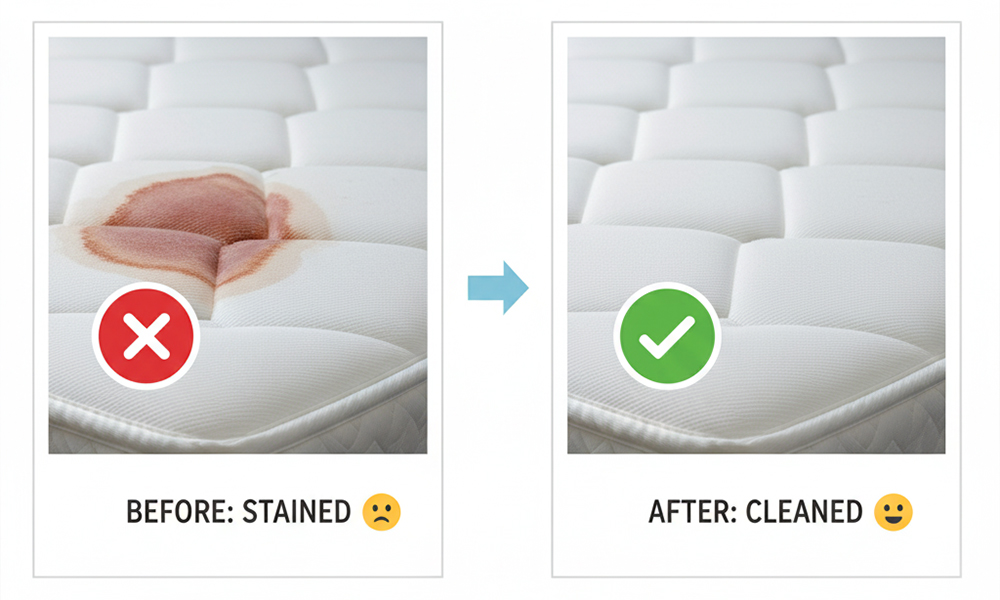
Twice-Yearly Flip and Rotate
Most modern mattresses benefit from rotation every three to six months. Rotate your mattress 180 degrees so that the foot end becomes the head end. However, avoid flipping certain types of mattresses, such as pillow-top, or single-sided mattresses, as doing so could damage them. If you have a double-sided mattress, flipping it over is an option. This practice prevents uneven wear and sagging, maintaining that cloud-like support.
How to Wash Pillows: Keeping Your Head in the Clouds
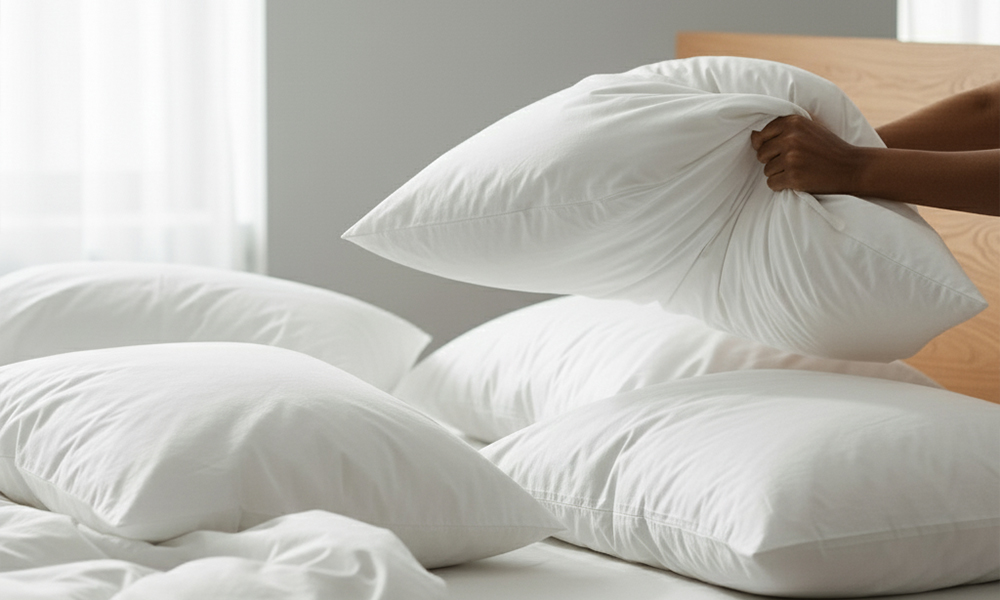
Pillows need attention, too. Most people don’t realize that pillows can harbor significant amounts of dust mites, dead skin cells, and oils. Here’s how to keep them fresh.
Before You Wash: Check the Care Label
Always read your pillow’s care label first. While many pillows are machine washable, some (like memory foam or latex) require special care.
Machine-Washable Pillows (Down, Feather, Polyester, Cotton)
Washing Process:
- Remove pillowcases and protectors.
- Check for tears and repair any before washing.
- Wash two pillows at once to balance the load.
- Use warm water and a gentle cycle.
- Add a small amount of mild detergent (too much can leave residue)
- Run an extra rinse cycle to remove all soap.
Drying Process:
- Dry on low to medium heat.
- Add clean tennis balls or dryer balls to help fluff and prevent clumping.
- Check every 30 minutes and fluff manually.
- Ensure pillows are completely dry before use (damp pillows can develop mold)
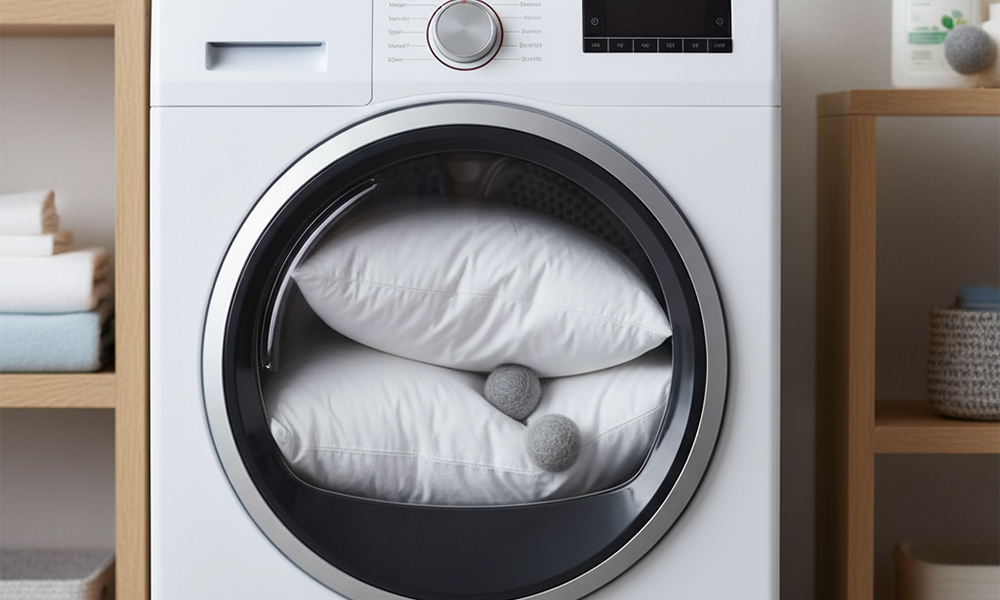
Special Care for Memory Foam and Latex Pillows
These materials should never go in the washing machine. Instead:
- Spot clean with a damp cloth and mild detergent.
- Air out regularly in a well-ventilated area.
- Use a removable, washable cover for protection.
- Vacuum occasionally with an upholstery attachment
How Often Should You Wash Pillows?
Wash your pillows every three to six months. However, wash pillowcases weekly and consider using pillow protectors that can be washed monthly for added bedding hygiene.
Bedding Hygiene: Creating a Complete Sleep Sanctuary
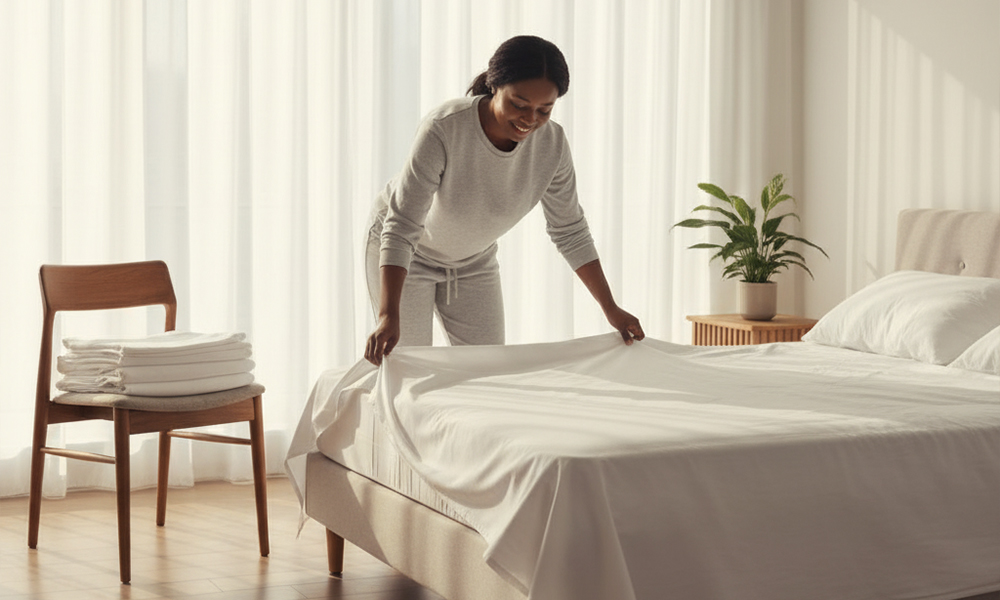
Mattress and pillow care is just part of the equation. Here’s how to maintain overall bedding hygiene:
Weekly Tasks
- Wash sheets, pillowcases, and duvet covers in hot water (check care labels first)
- Air out your mattress by pulling back the covers for 15-30 minutes.
- Spot clean any new stains immediately.
Monthly Tasks
- Wash mattress protector and pillow protectors.
- Vacuum mattress surface
- Wash blankets and decorative pillows.
Seasonal Tasks
- Deep clean mattress with baking soda treatment
- Wash or dry clean comforters and duvet inserts.
- Rotate mattress
- Evaluate pillow condition (replace if lumpy or flat)
Protection Is Prevention: Smart Mattress Care Tips
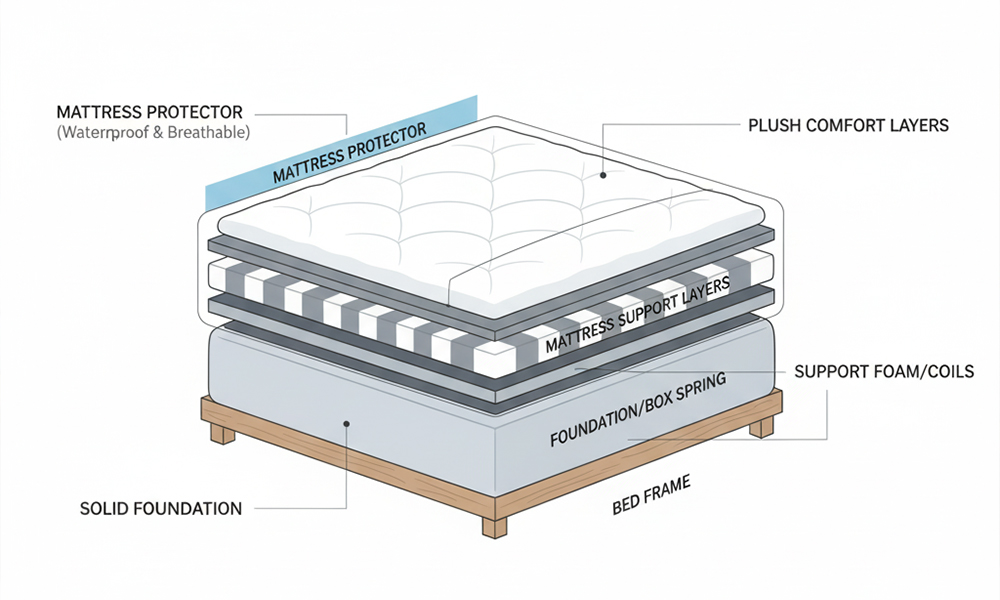
The easiest way to maintain your mattress is to protect it from the start:
Invest in Quality Protectors: A waterproof, breathable mattress protector creates a barrier against spills, sweat, and allergens while still allowing air circulation. This simple addition can dramatically extend your mattress’s life.
Use a Box Spring or Foundation. Proper support prevents sagging and maintains mattress structure. Never place a mattress directly on the floor, as this restricts airflow and can promote mold growth.
Keep Pets Off the Bed. Pet dander, dirt, and accidents can quickly compromise mattress cleanliness. If you do allow pets on your bed, use an extra protective layer and wash bedding more frequently.
Avoid Jumping or Standing: Mattresses aren’t designed to handle concentrated weight or impact, which can damage internal structures and create permanent indentations.
When to Replace: Knowing the Signs
Even with excellent care, mattresses and pillows don’t last forever. Replace your mattress every 7-10 years, or sooner if you notice:
- Visible sagging or indentations
- Increased allergy symptoms
- Waking up with aches and pains
- Noticeable wear or damage
Replace pillows every 1-2 years, or when they fail the “fold test” (if a pillow doesn’t spring back after being folded, it’s time for a new one).
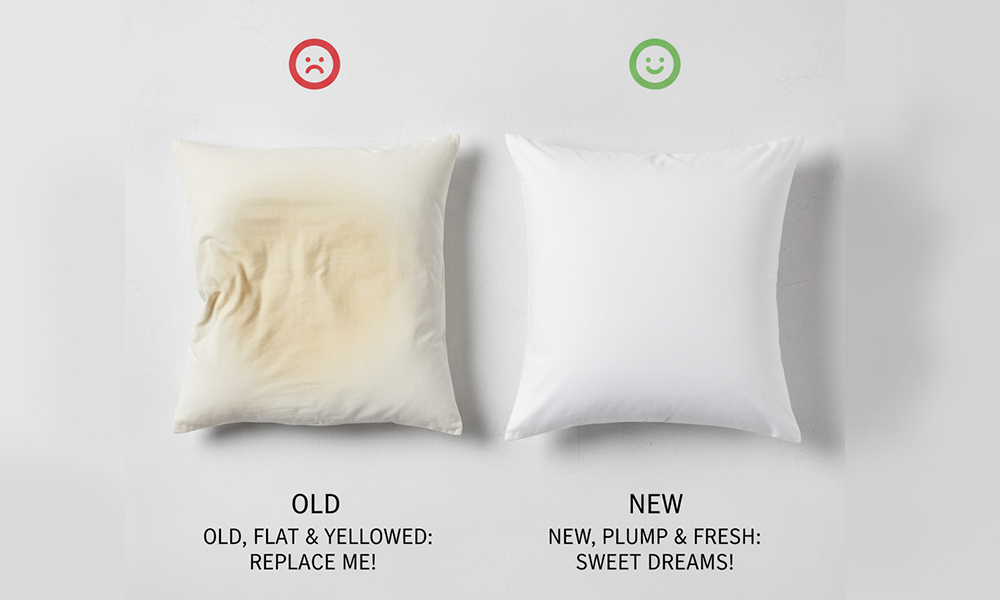
Your Investment in Better Sleep
Taking care of your mattress and pillows isn’t just about cleanliness—it’s about protecting your investment in quality sleep. With these maintenance routines, you’ll extend the life of your bedding, create a healthier sleep environment, and maintain that cloud-like comfort you deserve every night.
Remember, consistency is key. Set reminders for monthly vacuuming, quarterly rotations, and seasonal deep cleans. Your future self (and your well-rested body) will thank you.
Sweet dreams start with proper care. Now you have everything you need to keep sleeping on a cloud, night after night.













